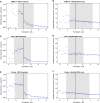Red Blood Cell Transfusion at a Hemoglobin Threshold of 7 g/dl in Critically Ill Patients: A Regression Discontinuity Study
- PMID: 35119978
- PMCID: PMC9278636
- DOI: 10.1513/AnnalsATS.202109-1078OC
Red Blood Cell Transfusion at a Hemoglobin Threshold of 7 g/dl in Critically Ill Patients: A Regression Discontinuity Study
Abstract
Rationale: In critically ill patients, a hemoglobin transfusion threshold of <7.0 g/dl compared with <10.0 g/dl improves organ dysfunction. However, it is unclear if transfusion at a hemoglobin of <7.0 g/dl is superior to no transfusion. Objectives: To compare degrees of organ dysfunction between transfusion and no transfusion at a hemoglobin threshold of <7.0 g/dl among critically ill patients using quasiexperimental regression discontinuity methods. Methods: We performed regression discontinuity analysis using hemoglobin measurements from patients admitted to intensive care units in three cohorts (Medical Information Mart for Intensive Care IV, eICU, and Premier Inc.), estimating the change in organ dysfunction (modified sequential organ failure assessment score) in the 24- to 72-hour window following each hemoglobin measurement. We compared hemoglobin concentrations just above and below 7.0 g/dl using a "fuzzy" discontinuity approach, based on the concept that measurement noise pseudorandomizes similar hemoglobin concentrations on either side of the transfusion threshold. Results: A total of 11,181, 13,664, and 167,142 patients were included in the Medical Information Mart for Intensive Care IV (MIMIC-IV), eICU, and Premier Inc. cohorts, respectively. Patient characteristics below the threshold did not differ from those above the threshold, except that crossing below the threshold resulted in a >20% absolute increase in transfusion rates in all three cohorts. Transfusion was associated with increases in hemoglobin concentration in the subsequent 24-72 hours (MIMIC-IV, 2.4 [95% confidence interval (CI), 1.1 to 3.6] g/dl; eICU, 0.7 [95% CI, 0.3 to 1.2] g/dl; Premier Inc., 1.9 [95% CI, 1.5 to 2.2] g/dl) but not with improvement in organ dysfunction (MIMIC-IV, 4.6 [95% CI, -1.2 to 10] points; eICU, 4.4 [95% CI, 0.9 to 7.8] points; Premier Inc., 1.1 [95% CI, -0.2 to 2.3] points) compared with no transfusion. Conclusions: Transfusion was not associated with improved organ dysfunction compared with no transfusion at a hemoglobin threshold of 7.0 g/dl, suggesting that evaluation of transfusion targets other than a hemoglobin threshold of 7.0 g/dl may be warranted.
Keywords: anemia; blood transfusion; critical illness; hemoglobin.
Figures

Comment in
-
Knowledge from the Noise: A Regression Discontinuity Design to Inform Optimal Transfusion Thresholds for Critically Ill Patients.Ann Am Thorac Soc. 2022 Jul;19(7):1099-1101. doi: 10.1513/AnnalsATS.202203-259ED. Ann Am Thorac Soc. 2022. PMID: 35772100 Free PMC article. No abstract available.
References
-
- Thomas J, Jensen L, Nahirniak S, Gibney RTN. Anemia and blood transfusion practices in the critically ill: a prospective cohort review. Heart Lung . 2010;39:217–225. - PubMed
-
- Docherty AB, Turgeon AF, Walsh TS. Best practice in critical care: anaemia in acute and critical illness. Transfus Med . 2018;28:181–189. - PubMed
-
- Hébert PC, Wells G, Blajchman MA, Marshall J, Martin C, Pagliarello G, et al. A multicenter, randomized, controlled clinical trial of transfusion requirements in critical care. Transfusion Requirements in Critical Care Investigators, Canadian Critical Care Trials group. N Engl J Med . 1999;340:409–417. - PubMed
-
- Carson JL, Stanworth SJ, Alexander JH, Roubinian N, Fergusson DA, Triulzi DJ, et al. Clinical trials evaluating red blood cell transfusion thresholds: an updated systematic review and with additional focus on patients with cardiovascular disease. Am Heart J . 2018;200:96–101. - PubMed
Publication types
MeSH terms
Substances
Grants and funding
LinkOut - more resources
Full Text Sources
Other Literature Sources
Medical

